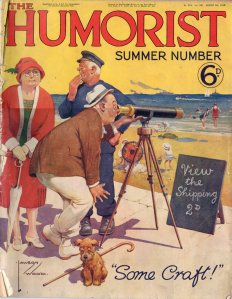The Humorist, published by Newnes appears to have run from 1922 to 1940 at which time it merged with the little pocket sized London Opinion. You can read a bit more here, bt the two magazines were totally different. The Humorist is bigger than A4 and London Opinion is almost A5.
Lawson Wood (23 August 1878 – 26 October 1957) drew the cover (please excuse the join – that’s my crude scanning) of this 1928 magazine which is full of gags. A quick search of Google Images shows that he was most famous for his chimpanzee drawings which I can remeber was the first time I encountered his work. Chris Beetles gallery has some original art for sale and the following is taken from that site:
Lawson Wood was an accomplished cartoonist and poster designer. He gained great popularity with his humorous illustrations of animals, including dinosaurs and monkeys. The ginger ape, Gran’pop, proved a particular favourite on both sides of the Atlantic.
Lawson Wood was born on 23 August 1878 into a notably artistic Highgate family: he was the eldest son of the landscapist, Lewis Pinhorn Wood, and the grandson of the architectural painter and printmaker, Lewis John Wood. Having spent his early life at Shere, near Guildford, Surrey, he studied in London at the Slade School of Art and Heatherley’s, and attended evening classes at Frank Calderon’s School of Animal Painting, Kensington. In 1896, at the age of eighteen, he joined the periodical publishers C Arthur Pearson Ltd, working there for six years and eventually becoming the chief staff artist. During the First World War, he served as an officer in the Kite Balloon Wing of the Royal Flying Corps. An accomplished poster designer, he drew cartoons for a number of periodicals, including the Graphic (1907-11), Punch, the Bystander, The Strand Magazine, Nash’s magazine and Fry’s magazine. Under the name of ‘Hustle Buck’, he collaborated with his son-in-law, Keith Sholto Douglas. He gained great popularity with his humorous illustrations of animals, including dinosaurs and apes; the monkey, Gran’pop, drawn for the Sketch was a particular favourite. Holding strict control over his copyright, he sold reproductions of his images throughout the world and even set up a factory that made toys to his own design. A member of the London Sketch Club, he was a close friend of Tom Browne, and also worked as a tutor for Percy Bradshaw’s Press Art School. Towards the end of his life he lived as something of a recluse in a mediaeval manor house that he had earlier discovered in Sussex and had rebuilt on a new site at Groombridge, Kent. He died in Sidmouth, Devon, on 26 October 1957.
